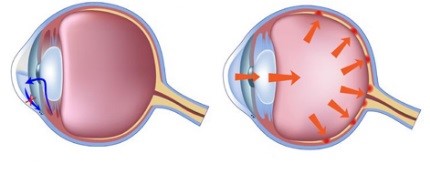Glaucoma
What is glaucoma?
It is a progressive eye disease causing changes in the nerve of the vision that is followed by the alterations in the vision field. Most frequent symptom of the illness is increased pressure in the eye.
Glaucoma is one of the main causes of blindness. This disease is usually observed for patients after 40 years of age. But discovered in due time loss of vision caused by glaucoma can be almost always prevented.
 |
 |
When looking at an object, the vision nerve transfers the image to the visual fields of the brain acting almost like an electric cable. It consists of millions of nerve fibers each of them containing different kind and amount of information while all together creating the central and peripheral or side vision. Glaucoma causes damage to these fibers causing dark spots in various part of our visual field. This lasts till permanent vision nerve damage has evolved. In case of full vision nerve damage, blindness is inevitable, however, if diagnosed priorily, blindness can be avoided.
So we can conclude that early glaucoma diagnostic and treatment done by ophthalmologists is essential for glaucoma or glaucoma complication prevention.
Causes and symptoms of glaucoma
There is a constant circulation of fluid in the eye that is produced by a gland called the ciliary body, and therefore there is also a special draining area to prevent the accumulation of this fluid. If any circumstances occur to block this passage, the fluid is accumulated in the eye causing a raise of the intraocular pressure which consequently may damage the vision nerve.
Four types of blockage are distinguished:
- The most common one is narrowing of these drainage passages due to various precipitates accumulating with age and is called a chronical open angle glaucoma, due to the fact that it gradually evolves for years. Even if the passages are not completely blocked, it still interferes with the normal circulation and causes a rise of the intraocular pressure, stealing the vision slowly one step at a time. This condition is observed in most cases of glaucoma and is the most dangerous one as well, as the process is too slow for the patient to notice any symptoms until vision loss occurs. To prevent a permanent damage of the vision nerve, regular eye doctor appointments are advisable.
- Another case, called hereditary glaucoma, occurs if these drainage passages have incompletely developed during the fetal period. As the walls of a child’s eyeball are much more elastic than adult’s, elevated intraocular pressure in this case causes them to stretch and as a result the eyeballs become larger, the cornea may become cloudy with the baby being sensitive to light. Although this is a rare condition, if any of the symptoms are observed, see an ophthalmologist as soon as possible.
- Now let’s imagine a rain water drainage on the street and a puddle near with a leaves floating in it, so what happens if the leaves floats on to the opening completely covering it? The water cannot pass into the drainage tube so it just accumulates on the street making the puddle bigger and bigger. Well, the iris of the eye can be compared to those leaves, because it may block the passages for draining fluid of the eye. This condition is an acute closed angle glaucoma, described with symptoms like blurry sight, sharp pain in the eye or surrounding it, colorful rings around light objects and nausea. Patient must see an ophthalmologist immediately because acute closed angle glaucoma may progress very rapidly, leading to complete vision loss even after just one day.
- Various other reasons, such as injuries, medication, bleeding, fever and/or inflammation lead to elevation of intraocular pressure as a consequence and may be the cause of secondary glaucoma.

How is glaucoma diagnosed?
During the ophthalmologist’s appointment intraocular pressure is measured which is an important symptom to approve glaucoma, the vision nerve is observed with ophthalmoscope, side vision is evaluated followed by all the other mandatory procedures. Be sure to answer all questions to inform the doctor about any hereditary or contributing factors factors, such as diabetes or calcification of arteries.
Considering all the results, the doctor decides whether immediate therapy is needed or the patient may be observed with suspicion of a developing glaucoma.
Sometimes the patient has eye pressure that exceeds the normal but lacks any other symptoms, that may be a normal condition for some without any further problems.
What are the possible treatments?
Usually eye drops decreasing pressure in the eye or helping the liquid to absorb, or eliminating amount of liquid that flows into the eye are used 2-4 times a day for the treatment and observation of glaucoma. To achieve good results medications should be used regularly and uninterruptedly.
Periodic follow-ups are obligatory for glaucoma patients because it can progress or regress without the patient noticing any changes. After evaluating changes in the development of each patient case, it is possible to change medications in due time. Damages caused by glaucoma can't be prevented but eye drops, capsules, as well as surgery prevent chances of further damages and allow retaining of vision. There may also be side effects to the therapy, of which most commonly reported is redness and soreness of the eyes and/or headache. Rarely also heart rate and breathing can also be affected so in these situations consult your ophthalmologist to reach a solution.
Glaucoma and patient
Therapy with medication can only be applied if the patient agrees to follow the doctor’s instructions correctly. From the moment glaucoma diagnosed is approved you and your doctor establish a team with a goal to prevent any progress of the condition. Therapy can only be terminated according to the doctor’s decision and in case of changing ophthalmologists, don’t forget to inform the new one about the medication being used at the moment.
Remember that you are in charge of your health and vision so if you’ve reached 40 years of age, an ophthalmologist should be seen at least once a year!
If you do not tolerate medications, or medications are not capable of reducing pressure in the eye, then surgery is needed. Sometimes it is enough to apply laser treatment but sometimes also surgical intervention is necessary to create the drainage channel. Still in these cases the recommended surgery is much safer and effective measure for retaining of the vision than to give glaucoma a possibility to develop and irreversibly harm the vision nerve.
What is glaucoma?
It is a progressive eye disease causing changes in the nerve of the vision that is followed by the alterations in the vision field. Most frequent symptom of the illness is increased pressure in the eye.
Glaucoma is one of the main causes of blindness. This disease is usually observed for patients after 35 years of age. But discovered in due time loss of vision caused by glaucoma can be almost always prevented.
When looking at an object, the vision nerve transfers the image to the visual fields of the brain acting almost like an electric cable. It consists of millions of nerve fibers each of them containing different kind and amount of information while all together creating the central and peripheral or side vision. Glaucoma causes damage to these fibers causing dark spots in various part of our visual field. This lasts till permanent vision nerve damage has evolved. In case of full vision nerve damage, blindness is inevitable, however, if diagnosed priorily, blindness can be avoided.
So we can conclude that early glaucoma diagnostic and treatment done by ophthalmologists is essential for glaucoma or glaucoma complication prevention.
Causes and symptoms of glaucoma
There is a constant circulation of fluid in the eye that is produced by a gland called the ciliary body, and therefore there is also a special draining area to prevent the accumulation of this fluid. If any circumstances occur to block this passage, the fluid is accumulated in the eye causing a raise of the intraocular pressure which consequently may damage the vision nerve.
Four types of blockage are distinguished:
The most common one is narrowing of these drainage passages due to various precipitates accumulating with age and is called a chronical open angle glaucoma, due to the fact that it gradually evolves for years. Even if the passages are not completely blocked, it still interferes with the normal circulation and causes a rise of the intraocular pressure, stealing the vision slowly one step at a time. This condition is observed in most cases of glaucoma and is the most dangerous one as well, as the process is too slow for the patient to notice any symptoms until vision loss occurs. To prevent a permanent damage of the vision nerve, regular eye doctor appointments are advisable.
Another case, called hereditary glaucoma, occurs if these drainage passages have incompletely developed during the fetal period. As the walls of a child’s eyeball are much more elastic than adult’s, elevated intraocular pressure in this case causes them to stretch and as a result the eyeballs become larger, the cornea may become cloudy with the baby being sensitive to light. Although this is a rare condition, if any of the symptoms are observed, see an ophthalmologist as soon as possible.
Now let’s imagine a rain water drainage on the street and a puddle near with a leaves floating in it, so what happens if the leaves floats on to the opening completely covering it? The water cannot pass into the drainage tube so it just accumulates on the street making the puddle bigger and bigger. Well, the iris of the eye can be compared to those leaves, because it may block the passages for draining fluid of the eye. This condition is an acute closed angle glaucoma, described with symptoms like blurry sight, sharp pain in the eye or surrounding it, colorful rings around light objects and nausea. Patient must see an ophthalmologist immediately because acute closed angle glaucoma may progress very rapidly, leading to complete vision loss even after just one day.
Various other reasons, such as injuries, medication, bleeding, fever and/or inflammation lead to elevation of intraocular pressure as a consequence and may be the cause of secondary glaucoma.
How is glaucoma diagnosed?
During the ophthalmologist’s appointment intraocular pressure is measured which is an important symptom to approve glaucoma, the vision nerve is observed with ophthalmoscope, side vision is evaluated followed by all the other mandatory procedures. Be sure to answer all questions to inform the doctor about any hereditary or contributing factors factors, such as diabetes or calcification of arteries.
Considering all the results, the doctor decides whether immediate therapy is needed or the patient may be observed with suspicion of a developing glaucoma.
Sometimes the patient has eye pressure that exceeds the normal but lacks any other symptoms, that may be a normal condition for some without any further problems.
What are the possible treatments?
Usually eye drops decreasing pressure in the eye or helping the liquid to absorb, or eliminating amount of liquid that flows into the eye are used 2-4 times a day for the treatment and observation of glaucoma. To achieve good results medications should be used regularly and uninterruptedly.
Periodic follow-ups are obligatory for glaucoma patients because it can progress or regress without the patient noticing any changes. After evaluating changes in the development of each patient case, it is possible to change medications in due time. Damages caused by glaucoma can't be prevented but eye drops, capsules, as well as surgery prevent chances of further damages and allow retaining of vision. There may also be side effects to the therapy, of which most commonly reported is redness and soreness of the eyes and/or headache. Rarely also heart rate and breathing can also be affected so in these situations consult your ophthalmologist to reach a solution.
Glaucoma and patient
Therapy with medication can only be applied if the patient agrees to follow the doctor’s instructions correctly. From the moment glaucoma diagnosed is approved you and your doctor establish a team with a goal to prevent any progress of the condition. Therapy can only be terminated according to the doctor’s decision and in case of changing ophthalmologists, don’t forget to inform the new one about the medication being used at the moment.
Remember that you are in charge of your health and vision so if you’ve reached 40 years of age, an ophthalmologist should be seen at least once a year!
If you do not tolerate medications, or medications are not capable of reducing pressure in the eye, then surgery is needed. Sometimes it is enough to apply laser treatment but sometimes also surgical intervention is necessary to create the drainage channel. Still in these cases the recommended surgery is much safer and effective measure for retaining of the vision than to give glaucoma a possibility to develop and irreversibly harm the vision nerve.




